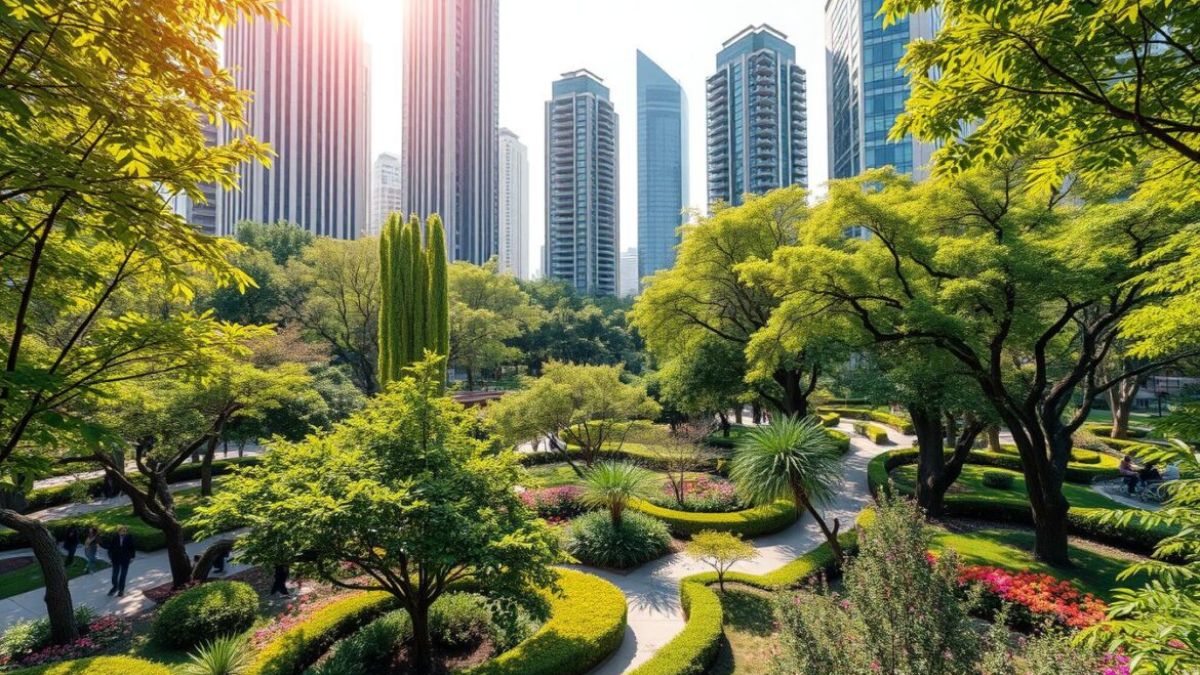Real Estate
Axurbain: Blending Nature with Modernity in Urban Spaces

Imagine walking through a bustling city, surrounded by towering skyscrapers and the hum of urban life. Now picture that same scene infused with vibrant greenery, colorful flowers, and serene water features. This is the essence of axurbain—a revolutionary approach to urban design that harmoniously merges nature with modernity.
As cities continue to expand and evolve, the need for sustainable living spaces has never been more pressing. Axurbain offers a solution by integrating natural elements into our concrete jungles. It transforms ordinary public areas into lush oases where residents can relax, socialize, and reconnect with nature.
Join us as we explore what axurbain truly means, its benefits for urban environments, inspiring case studies from around the globe, and how it could shape future cities. Let’s dive into this exciting blend of innovation and ecology!
What is Axurbain?
Axurbain is a pioneering concept that reimagines urban living by incorporating nature into city spaces. It brings together the vibrancy of greenery with modern architectural designs, creating environments that are both functional and aesthetically pleasing.
At its core, axurbain emphasizes sustainability. This approach seeks to reduce urban heat while enhancing air quality through strategic landscaping. Parks, green roofs, and vertical gardens become essential components of city planning.
Beyond aesthetics, axurbain promotes well-being. Access to natural elements has been shown to improve mental health and foster community interactions.
By blending nature with contemporary infrastructure, axurbain not only beautifies cities but also creates healthier habitats for residents and wildlife alike. It’s about cultivating places where people thrive alongside their surroundings in harmony.
The Concept of Blending Nature with Modernity
Blending nature with modernity creates a harmonious environment that benefits both people and the planet. This concept emphasizes integrating green elements into urban landscapes, fostering a connection to the natural world.
Urban areas often feel disconnected from nature. By introducing parks, vertical gardens, and green roofs, cities can transform into vibrant ecosystems. These features do more than beautify; they improve air quality and enhance mental well-being.
The design of public spaces plays a crucial role in this integration. Thoughtful architecture incorporates natural light and greenery to create inviting atmospheres.
Moreover, blending these two elements encourages sustainable living practices. It promotes biodiversity while also addressing climate challenges within urban settings.
This approach invites community engagement as residents interact with their surroundings in meaningful ways. The fusion of technology with organic forms ignites creativity, inspiring innovative solutions for future urban development.
Benefits of Incorporating Nature in Urban Spaces
Incorporating nature into urban spaces offers a multitude of benefits that enhance the quality of life for city dwellers. Green areas, such as parks and gardens, provide essential breathing space amidst concrete surroundings.
These natural elements promote mental well-being by reducing stress levels. Studies show that time spent in nature can lead to improved mood and creativity.
Biodiversity thrives when urban environments embrace greenery. Plants attract various species, fostering ecological balance within densely populated areas.
Moreover, green spaces contribute to better air quality by filtering pollutants and releasing oxygen. They help mitigate heat islands, making cities cooler during sweltering summers.
Urban gardening initiatives encourage community bonding. Residents come together to cultivate shared spaces while enjoying fresh produce right at their doorstep.
The aesthetic appeal of nature enhances property values too, drawing potential buyers who prioritize access to beautiful landscapes within bustling cities.
Case Studies: Successful Implementation of Axurbain in Different Cities
Cities around the world are embracing axurbain principles with remarkable success. In Singapore, vertical gardens have transformed high-rise buildings into living ecosystems. These green facades not only enhance aesthetics but also improve air quality.
Barcelona offers another striking example. The city has integrated urban parks within densely populated neighborhoods. This initiative encourages community interaction while providing essential green spaces for residents and wildlife alike.
In New York City, the High Line is a celebrated model of axurbain design. Once an unused railway line, it now features lush greenery and art installations that unite nature with urban life, attracting millions annually.
Meanwhile, in Melbourne, innovative rooftop gardens on commercial buildings contribute to biodiversity and reduce heat island effects. Local initiatives showcase how blending nature with modernity can create vibrant living environments that benefit everyone involved.
Challenges and Solutions for Implementing Axurbain
Implementing axurbain concepts often faces several challenges. One significant hurdle is the resistance to change from traditional urban planning methodologies. Many stakeholders may hesitate to embrace a new vision, fearing the disruption of established systems.
Funding can be another obstacle. Integrating nature into urban designs typically requires upfront investment that some municipalities might struggle to secure. Finding innovative financing options is crucial for overcoming this barrier.
Additionally, there can be logistical issues in blending natural elements with existing infrastructure. Effective collaboration between architects, city planners, and environmental experts is essential in addressing these complexities.
Public perception also plays a pivotal role. Educating communities about the long-term benefits of axurbain can help garner support and enthusiasm for such projects. Communicating success stories from other cities can inspire confidence and promote acceptance among residents and local businesses alike.
Future Possibilities for Axurbain in Urban Planning
The future of axurbain in urban planning is bright and innovative. As cities continue to grow, the integration of green spaces will become increasingly vital. Imagine skyscrapers adorned with vertical gardens, creating a seamless connection between nature and architecture.
Smart technology can play a significant role here. By using sensors and data analytics, we can monitor environmental conditions and optimize plant growth in urban areas. This tech-savvy approach ensures that green spaces thrive even amidst concrete landscapes.
Community involvement is crucial for the success of axurbain projects. Engaging local residents fosters a sense of ownership and responsibility towards these natural elements within their neighborhoods.
Moreover, sustainable practices will evolve alongside axurbain methodologies. Eco-friendly materials for construction combined with renewable energy sources could transform how we think about building design.
As urban planners embrace this approach, cities may become more resilient, healthier places to live while fostering biodiversity right at our doorsteps.
Conclusion
Axurbain represents a transformative approach to urban planning. By seamlessly integrating nature with modern architecture, cities can enhance the quality of life for their residents. The concept encourages sustainability while fostering community connections.
Cities that have embraced axurbain are witnessing tangible benefits. Green spaces improve air quality and promote physical health. Additionally, they create more vibrant social environments where people can gather and interact.
However, implementing this vision comes with challenges. Space constraints and budget limitations often hinder projects from fully realizing their potential. Yet innovative solutions—like vertical gardens or rooftop parks—are proving effective in overcoming these hurdles.
As we look ahead, the future possibilities for axurbain are vast and inspiring. Urban areas worldwide could evolve into lush landscapes that prioritize both ecological balance and human experience.
The journey towards blending nature with modernity is just beginning, but its implications can reshape our cities for generations to come.

-

 Digital & Marketing3 months ago
Digital & Marketing3 months agoHow هنتاوي.com is Revolutionizing Content Sharing and Discovery
-

 Crypto5 months ago
Crypto5 months agoICOSTAMP.com – Everything You Need to Know About ICOs
-

 Finance5 months ago
Finance5 months agoEnhance Your Portfolio with the White Oak Impact Fund
-

 Topic3 months ago
Topic3 months agoHow to Care for Your Shihuanuo: Tips and Best Practices
-

 Entertainment5 months ago
Entertainment5 months agoTaylor Swift’s Producer Hints at New Album Release This Year
-

 Technology3 months ago
Technology3 months agoExploring TechPondrk. in: The Future of Technology Innovation
-

 Sports & Games3 months ago
Sports & Games3 months agoThe Evolution of Puzzles: How the XL NYT Crossword Redefines Wordplay
-

 Biography3 months ago
Biography3 months agoWhy Mike Wolfe Passion Project Matters: Lessons Learned from a Lifelong Collector